press release —
The scientist from the Max Planck Institute of Quantum Optics is honoured for his contributions to attosecond physics.
Ferenc Krausz, Director at the Max Planck Institute of Quantum Optics and Professor at the Ludwig Maximilian University of Munich, together with Pierre Agostini and Anne L'Huillier, has been honoured with the 2023 Nobel Prize in Physics. The Nobel Committee is honouring the two reserachers for the foundation of attosecond physics. An attosecond is the billionth part of a billionth of a second. Laser pulses lasting only a few attoseconds can be used to track the movements of individual electrons. This not only provides fundamental insights into the behaviour of electrons in atoms, molecules and solids, but could also help to develop electronic components more quickly.
News
-
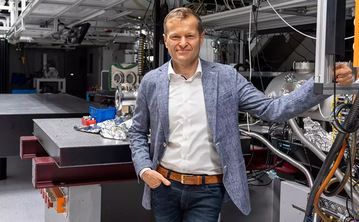 October 3, 2023Nobel Prize in Physics 2023 for Ferenc Krausz
October 3, 2023Nobel Prize in Physics 2023 for Ferenc Krausz -
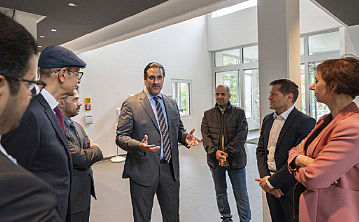 May 9, 2023Vice President of King Saud University visits the MPQ
May 9, 2023Vice President of King Saud University visits the MPQshort report — With the visit of Prof. Dr. Yazeed A Al-Sheikh, Vice President of King Saud University (KSU) for research and graduate studies, the successful long standing cooperation of the attoworld team at MPQ-LMU with King Saud University has gained new momentum. A comprehensive overview of the research activities of MPQ was presented to Prof. Dr. Yazeed A Al-Sheikh. He emphasized that the KSU wants to further expand and consolidate the cooperation. This include the opportunity to further discuss the different framework approaches to strengthen this fruitful collaboration between KSU-MPQ-LMU in education, research and innovation in many other areas.
-
 February 22, 2022Sensing light
February 22, 2022Sensing lightpress release —
Physicists of the attoworld-team at Ludwig-Maximilians-Universität have uncovered what happens during the sampling of a light field. This helped them increase the sensitivity of the measurement by up to one order of magnitude.
-
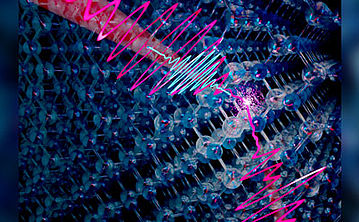 January 7, 2022Exploration of new frequency frontiers
January 7, 2022Exploration of new frequency frontierspress release — An international team of physicists under the leadership of Prof. Matthias Kling at the Ludwig-Maximilians-Universität and the Max-Planck-Institute for Quantum Optics has extended a measurement method for the observation of light-induced processes in solids.
-
 December 6, 2021A prospective pilot study on breast cancer detection
December 6, 2021A prospective pilot study on breast cancer detectionshort report — Breast cancer screening is currently predominantly based on mammography, tainted with the occurrence of both false positivity and false negativity, urging for innovative strategies, as effective detection of early-stage breast cancer bears the potential to reduce mortality. In a recent publication in the scientific journal “BMC Cancer”, the BIRD team and colleagues from the King Saud University (KSU) and the International Cancer Research Group (ICRG) report the results of a prospective pilot study on breast-cancer detection using blood plasma analyzed by Fourier-transform infrared (FTIR) spectroscopy – a rapid, cost-effective technique with minimal sample volume requirements and potential to aid biomedical diagnostics. FTIR has the capacity to probe health phenotypes via the investigation of the full repertoire of molecular species within a sample at once, within a single measurement in a high-throughput manner. In this study, the researchers take advantage of cross-molecular fingerprinting to probe for breast cancer detection.
Graphic: Kosmas Kepesidis
Original publication:
Kosmas V. Kepesidis, Masa Bozic‑Iven, Marinus Huber, Nashwa Abdel‑Aziz, Sharif Kullab, Ahmed Abdelwarith, Abdulrahman Al Diab, Mohammed Al Ghamdi, Muath Abu Hilal, Mohun R. K. Bahadoor, Abhishake Sharma, Farida Dabouz, Maria Arafah, Abdallah M. Azzeer, Ferenc Krausz, Khalid Alsaleh, Mihaela Zigman and Jean‑Marc Nabholtz
Breast-cancer detection using blood-based infrared molecular fingerprints
BMC Cancer (2021) 21:1287
https://doi.org/10.1186/s12885-021-09017-7 -
 November 12, 2021Blood samples for “Early Cancer Detection with Lasers” (ECDL) research
November 12, 2021Blood samples for “Early Cancer Detection with Lasers” (ECDL) researchshort report — In the framework of the “Early Cancer Detection with Lasers” collaboration (ECDL) the King Saud University (KSU) and the Oncology Centre of the King Saud University Medical City (KSUMC) are collaborating with the Ludwig-Maximilians-Universität München. Within this framework, a larger quantity of blood samples has now left the laboratories of Saudi Arabia and reached Germany. The international ECDL project is designed to use infrared laser spectroscopy to detect molecules in blood that indicate cancer. KSU and KSUMC are the international partners in this project. Its researchers are thus helping to develop new methods for the early detection of cancer using pioneering technologies. More info: www.attoworld.de/bird
-
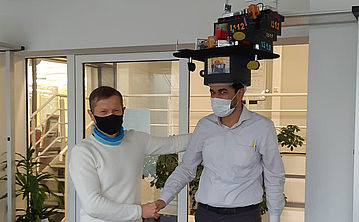 February 3, 2021Congratulations to Dr. Ali Hussain!
February 3, 2021Congratulations to Dr. Ali Hussain!short report — Ali Hussain has defended his doctoral thesis titled: “Field resolving spectrometer for mid-infrared molecular spectroscopy”. We congratulate warmly on passing successfully the exam.
-
 October 15, 2020X-ray light in overdrive
October 15, 2020X-ray light in overdrivepress release — An international collaboration, with physicists from the Ludwig-Maximilians-Universität Munich, the Max Planck Institute of Quantum Optics, and the King-Saud University in Riyad, has shown attosecond pulse generation under extreme conditions.
-
 May 11, 2020Quantum brakes in molecules
May 11, 2020Quantum brakes in moleculespress release — Physicists of the Laboratory for Attosecond Physics have measured the flight times of electrons in molecules after their creation with light. The small quantum particles were emitted from a specific atom within the molecules, which enabled to measure the molecular influence on their emission time. The results open new opportunities to study the forces that are holding molecules together in better detail.
-
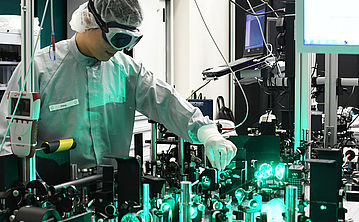 February 14, 2020A new laser source for the analysis of molecular fingerprints
February 14, 2020A new laser source for the analysis of molecular fingerprintspress release — Controlling, shaping, and measuring the electric field of light at sub-cycle regime enhances the depth of our insight into microscopic ultrafast dynamics at femtosecond and attosecond time scale. Our developed laser architecture fulfills these criteria.
On the one hand, the system allows to generate optimized, non-sinusoidal pulses with scalable peak and average-power for attosecond pulse generation.
On the other hand, the system enabled us to detect the electric field of the absorbed light by water molecules at near infrared spectral range for the first time. The demonstrated control and measurement of the electric field of light at petahertz holds promise to open up new opportunities for precise observation and control of molecular vibrations over the entire molecular fingerprint region down to a few femtosecond time scales. -
 February 5, 2020Dr. Ayman Alismail
February 5, 2020Dr. Ayman Alismailshort report — Ayman Alismail has defended his doctoral thesis: »Multi-Octave, CEP-Stable Source for High-Energy Field Synthesis«
-
 January 2, 2020Field-resolved infrared spectroscopy of biological systems
January 2, 2020Field-resolved infrared spectroscopy of biological systemspress release — In cooperation between the Laboratory of Attosecond Physics at the Max Planck Institute of Quantum Optics and the Centre for Advanced Laser Applications of the Ludwig-Maximilians-Universität München, the King Saud University Riad and the Center for Molecular Fingerprinting (Budapest, Hungary), we have developed a molecular spectroscopy technique that overcomes long-standing limitations of traditional techniques, like Fourier-transform infrared spectroscopy.
-
 November 6, 2019King Abdulaziz First Class Medal
November 6, 2019King Abdulaziz First Class Medalshort report — The custodian of the Two Holy Mosques King Salman awarded the King Abdulaziz First Class Medal - Saudi Arabia’s highest civilian honor - to Prof. Dr. Abdallah Azzeer, the director of Attosecond Science laboratory (ASL) at King Saud University (KSU). The minister of education delivered the medal in presence of Saudi university rectors.
The medal was awarded to Prof. Dr. Azzeer for his distinctive role in establishing a successful research collaboration between KSU and Max Planck Institute for Quantum Optics (MPQ) and Ludwig Maximilian University (LMU) of Munich. This led to the launching of a new cutting-edge laser laboratory at KSU in 2015.
Prof. Dr. Azzeer has expressed his great gratitude to the Custodian of the Two Holy Mosques King Salman Ibn Abdulaziz for award him the King Abdulaziz First Class Medal. -
 July 30, 2018A Glimpse into the Labs
July 30, 2018A Glimpse into the Labsshort report — The students from Saudi Arabia were able to have a detailed look at the laboratories at the Ludwig-Maximilians-Universitaet last week Thursday. In the cleanroom Dr. Vladimir Pervak explained to Abdullah Ali Alshehri, Ibrahim Abdullah Almuhanna, Rayan Khalid Alzahrani, Lamyaa Alasim and Saleha Mansour Alshalwi, how the production of optics for ultra-short-time laser physics works. Also included in the tour were the laboratories of Prof. Matthias Kling. The students are guests in the LAP team until the end of July, as a part of the Summer School for Quantum Optics;, a joint project between the Ludwig-Maximilians-Universitaet and the King Saud University.
-
 July 3, 2018Summer School Students
July 3, 2018Summer School Studentsshort report — The Laboratory of Attosecond Physics (LAP) at the Max Planck Institute of Quantum Optics and the Ludwig-Maximilians-Universität is hosting guests from Saudi Arabia this summer. For one month Abdullah Ali Alshehri, Ibrahim Abdullah Almuhanna, Rayan Khalid Alzahrani, Lamyaa Alasim and Saleha Mansour Alshalwi will be completing the Summer School for Quantum Optics in the LAP team’s research groups. All five participants are studying physics. The summer school is a joint project of the LAP team and the King Saud University in Riyadh. At the Max Planck Institute of Quantum Optics, the students will work in the laboratories, as well as attend lectures and round table discussions with senior scientists. We wish them a successful and eventful stay here!
-
 April 23, 2018Molecules brilliantly illuminated
April 23, 2018Molecules brilliantly illuminatedpress release — Molecules are the building blocks of life. Like all other organisms, we are made of them. They control our biorhythm, and they can also reflect our state of health. Researchers at the Laboratory for Attosecond Physics (LAP) – a joint venture between Ludwig-Maximilians-Universität (LMU) and the Max Planck Institute of Quantum Optics (MPQ) in Garching near Munich – want to use brilliant infrared light to study molecular disease markers in much greater detail, for example to facilitate early stage cancer diagnosis. The team has developed a powerful femtosecond light source which emits at wavelengths between 1.6 and 10.2 micrometers. This instrument should make it possible to detect organic molecules present in extremely low concentrations in blood or aspirated air.
-
 December 11, 2017Prof. Nasser M. Al-Daghri visits Garching
December 11, 2017Prof. Nasser M. Al-Daghri visits Garchingshort report — Together with Prof. Abdallah Azzeer, Prof. Nasser M. Al-Daghri from King-Saud-University has complied with an invitation of Prof. F. Krausz to pay a visit to his MPQ-LMU laboratories and present a colloquium about his research on the 4-5th of December 2017. Prof. Nasser has an impressive track record in biomarker discovery. His lab has a variety of biochemical tools which will be used in the cooperation as valuable benchmarking methods for the analysis of blood samples. Moreover Dr. Nasser has built up a large biorepository from more than tens of thousands of Arab children as well as tens of thousands of adults in Saudi Arabia. His great deal of expertise in biomarker research together with his biorepository might provide important contributions to testing the applicability of field-resolved infrared molecular fingerprinting for biomedical diagnostics of other chronic diseases, such as diabetes mellitus. The utility of this approach, which had been developed in the laboratories of Prof. Krausz, is currently being studied in another collaboration with Profs. Jean-Marc Nabholtz and Khalid Al-Saleh for early detection of breast cancer. Following his excellent talk, which was received with great interest, Prof. Nasser and Prof. Azzeer discussed possibilities of starting a collaboration in the above research direction. Prof. Nasser, Prof. Azzeer and Prof. Krausz agreed to continue discussions about a starting joint activities upon Prof. Krausz’ upcoming visit at KSU.
-
 November 20, 2017»Don’t miss the chance to try some of the breads«
November 20, 2017»Don’t miss the chance to try some of the breads«interview — Ayman Alismail, a PhD student from the King Saud University in Saudi Arabia, is working on his doctoral thesis at the Laboratory of Attosecond Physics of the Ludwig-Maximilians-Universität München. Here he reports on what it is like to live and work in Germany.
-
 October 11, 2017Two Cultures – One Goal!
October 11, 2017Two Cultures – One Goal!interview — Dr. Abdallah Azzeer is Director of the Attosecond Science Laboratory (ASL) at the King Saud University (KSU) in Riyadh. In his interview with MPQ Newsletter, he speaks enthusiastically about the relation between the MPQ and the KSU, the first attosecond flash achieved in the Arab world, and the wonder of international science. It is important to him to build the best environment for the next generation of scientists in the field of attosecond physics.
-
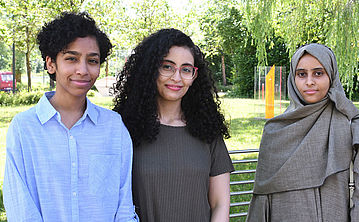 July 4, 2017We welcome our guests from Riyadh!
July 4, 2017We welcome our guests from Riyadh!short report — Today, we welcome visitors from Saudi Arabia to the Laboratory for Attosecond Physics. Nouf Jaber, Al Batool Aba Al-Khahil and Zainah Ali Al-Qahtani are studying at King Saud Universityin Riyadh, and have come to the Max Planck Institute of Quantum Optics for a month to broaden their knowledge of laser physics. As part of our collaboration with the King Saud University, we plan to hold regular Summer Schools specifically for female physicists from Saudi Arabia in the coming years. It is a pleasure to welcome this first group to Munich. We wish them every success, and hope they enjoy their stay in the Institute and in the city.
-
 May 31, 2016Attosecond camera for nanostructures
May 31, 2016Attosecond camera for nanostructurespress release — The interaction between light and matter is of key importance in nature, the most prominent example being photosynthesis. Light-matter interactions have also been used extensively in technology, and will continue to be important in electronics of the future. A technology that could transfer and save data encoded on light waves would be 100.000-times faster than current systems. A light-matter interaction which could pave the way to such light-driven electronics has been investigated by scientists from the Laboratory for Attosecond Physics (LAP) at the Ludwig-Maximilians-Universität (LMU) and the Max Planck Institute of Quantum Optics (MPQ), in collaboration with colleagues from the Chair for Laser Physics at the Friedrich-Alexander-Universität Erlangen-Nürnberg. The researchers sent intense laser pulses onto a tiny nanowire made of gold. The ultrashort laser pulses excited vibrations of the freely moving electrons in the metal. This resulted in electromagnetic »near-fields« at the surface of the wire. The near-fields oscillated with a shift of a few hundred attoseconds with respect to the exciting laser field (one attosecond is a billionth of a billionth of a second). This shift was measured using attosecond light pulses which the scientists subsequently sent onto the nanowire.
-
 May 12, 2016Laser pulses: conductors for protons
May 12, 2016Laser pulses: conductors for protonspress release — Light can conduct the play of atoms and molecules in the microcosm. Humans manage to interfere with this play. Researchers from the Laboratory of Attosecond Physics (LAP) of the Max Planck Institute of Quantum Optics (MPQ) and the Ludwig-Maximilians-Universität(LMU) and from the Department of Chemistry at the LMU have now used light to reconfigure hydrocarbons. Using ultrashort laser pulses they removed an outer hydrogen atom from one side of a hydrocarbon molecule and directed it to the opposite side, where it reattached. The method could be used in the future to synthesize new substances by controlling chemical reactions.
-
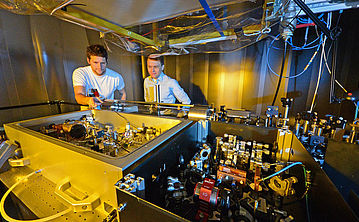 September 22, 2015Laser Pulses For Cancer Detection
September 22, 2015Laser Pulses For Cancer Detectionpress release — Scientists often need to detect and measure levels of specific substances in a sea of irrelevant molecules, and infrared light offers an ideal tool for this task. Infrared radiation is invisible to the human eye, but molecules react with mid-infrared light in ways that are extremely sensitive to their precise atomic structure. This provides a means of identifying with great specificity molecular solutes present in very low concentrations. Lasers that generate light in the mid-infrared range suitable for use in molecular sensors are therefore the subject of intensive research. Now teams from the Ludwig-Maximilians-Universität (LMU) and the Laboratory for Attosecond Physics at the Max Planck Institute of Quantum Optics (MPQ), in collaboration with the Institute of Photonic Sciences (ICFO) in Barcelona, have developed a unique source of coherent radiation for this purpose.
-
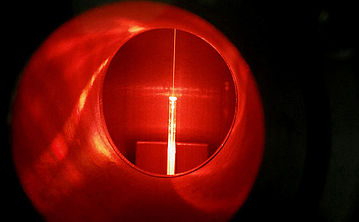 July 16, 2015First isolated attosecond pulses in Saudi-Arabia
July 16, 2015First isolated attosecond pulses in Saudi-Arabiashort report — The science of ultrashort metrology in the Attosecond Science Laboratory (ASL) in Riyadh picks up speed. The German/Saudi-Arabian team of physicists led by Prof. Ferenc Krausz and Prof. Abdallah Azzeer produced as the first team in the Arabic World isolated attosecond pulses in the ASL laboratory of the King Saud University in Riyadh. A big success for ultrafast physics in Saudi-Arabia. Attosecond-short light flashes are used for taking photographs of electrons. The team plans to observe the dynamics of electrons in molecules in the time dimension of attoseconds in order to examine processes in molecules in photoemission. During photoemission electrons are knocked out of atoms by photons (i. e. by light). This process is a major cause of damages to living cells. Increased knowledge about photoemission is thus crucial not only for physics, but also for medicine.
-
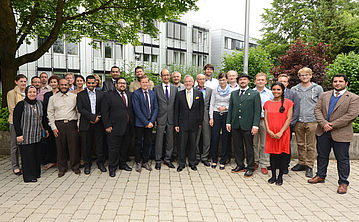 June 12, 2015Spotlight on Early Cancer Detection with Lasers (ECDL) – workshop at MPQ Garching
June 12, 2015Spotlight on Early Cancer Detection with Lasers (ECDL) – workshop at MPQ Garchingshort report — It would be tremendously beneficial to develop ways to detect and tackle cancerous development at a much earlier stage of the disease than is presently possible. Last week on June 11th and 12th 2015, a workshop was held at the Max Planck Institute of Quantum Optics (MPQ) to discuss the latest advances, perspectives and challenges in the emerging research area of early cancer detection. The workshop served to discuss joint efforts by scientists from the fields of cutting-edge laser physics, cell biology, cancer medicine, biochemistry and bioinformatics from MPQ, Ludwig Maximilian University (LMU), University of Innsbruck (Austria) as well as King Saud University (Riyadh, Saudi Arabia). Joint inter-disciplinary efforts and new approaches are building a bridge between novel laser technologies and clinically relevant cancer detection. These collaborative efforts have the potential to provide a springboard to detect cancerous onset earlier than ever.
-
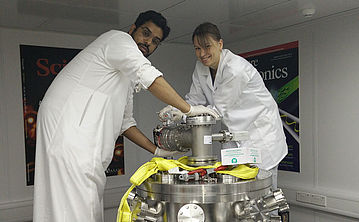 April 24, 2015New team member for the ASL in Riyadh – Dr. Nora Kling
April 24, 2015New team member for the ASL in Riyadh – Dr. Nora Klingshort report — The King Saud University welcomed Dr. Nora Kling, postdoc at the LMU, as a new co-worker in the Attosecond Science Laboratory in Riyadh. Together with Wolfgang Schweinberger and her colleagues from the KSU she is now working on the first laser experiments. »The attosecond lab in Riyadh is top notch, so it is natural to want to be a part of it. It is great to have the opportunity to work with world class researchers at KSU and MPQ/LMU together in Saudi Arabia«, Nora Kling says, »I am gaining new experiences regarding light-matter interactions on ultrafast timescales as well as becoming more culturally connected to the world.«
-
 April 18, 2015Seehofer visits the new attosecond laboratory in Riyadh
April 18, 2015Seehofer visits the new attosecond laboratory in Riyadhshort report — During his visit to Saudi Arabia the Bavarian prime minister Horst Seehofer visited the King Saud University in Riyadh. After a short ride, leading through the whole campus, Seehofer went to the new Attosecond Science laboratory, which is run by the KSU in cooperation with the LMU Munich and the Max Planck Institute for Quantum Optics. Here, Saudi Arabian Scientists and their Munich colleagues will research the movements of electrons together. Seehofer was impressed by the complex fundamental research and the unique collaboration. LMU rector Prof. Bernd Huber and Prof. Badran A. Al-omar (rector of the KSU), joined many journalists and members of the delegation for Seehofer’s visit to the lab, which lasted about half an hour.
-
 February 18, 2015Ultrafast Photography in Saudi Arabia
February 18, 2015Ultrafast Photography in Saudi Arabiapress release — Electrons cannot hide anymore – even in Saudi Arabia. On February 16th, 2015, the new »Attosecond Science Laboratory« will be inaugurated at the King Saud University in Riyadh. It is the first attosecond laboratory in the whole Arabic world and a product of the collaboration between the Ludwig Maximilians University (LMU) Munich, the Max Planck Institute for Quantum Optics (MPQ) in Garching, and the King Saud University (KSU) in Riyadh. Researchers from the three institutions will use the new facility to investigate electrons in motion.
-
 February 17, 2015Attosecond Science Laboratory in Riyadh
February 17, 2015Attosecond Science Laboratory in Riyadhshort report — It's done - Nobel laureate Prof. Theodor Hänsch cut the ribbon and opened therewith the new Attosecond Science Laboratory in Riyadh. Here students are able to access high-class technology to develope and improve the research of attosecond physics. The ceremony was a big success and was highlighted by lectures of the three eminent scientists Paul Corkum, Gérard Mourou and Nobel laureate Theodor Hänsch.
-
 May 8, 2014Light control of bond breaking in symmetric molecules
May 8, 2014Light control of bond breaking in symmetric moleculespress release — Chemical bonds between carbon and hydrogen atoms are amongst the strongest in nature and their selective breaking, in particular in symmetric molecules, is of interest to chemical synthesis and the development of new biologically active molecules. An international team of scientists has now demonstrated that ultrashort light pulses with perfectly controlled waveforms can selectively break C-H bonds in acetylene ions. The researchers demonstrated that a suitable choice of the laser-pulse waveform leads to breaking of the C-H bond on the left (or right) side of the symmetric H-C≡C-H molecule. The scientists propose that their results can be understood by a new quantum control mechanism based on light induced vibration (Nature Communications, DOI:10.1038/ncomms4800).
-
 March 1, 2014Workshop on »Early cancer diagnosis with laser light«
March 1, 2014Workshop on »Early cancer diagnosis with laser light«short report — Experts from KSU, LMU and the University of Innsbruck discussed new opportunities in early cancer diagnosis and treatment with next generation laser sources. The topics for future collaborative efforts include the development of the light sources, optical tools for breath analysis, in-vitro and in-vivo multi-photon fluorescence microscopy and nanoparticle mediated diagnosis and treatment of cancer.
-
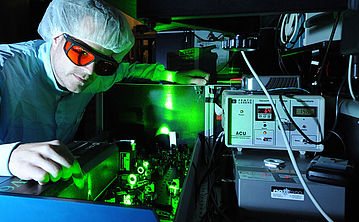 January 12, 2014Solid-state light-wave detector
January 12, 2014Solid-state light-wave detectorpress release — A team in the Laboratory for Attosecond Physics (LAP) at the Max-Planck-Institute of Quantum Optics has taken another step toward the achievement of complete control over the waveform of pulsed laser light. Together with colleagues based at LMU and the Technische Universität München (TUM), they have constructed a detector which provides a detailed picture of the waveforms of laser pulses that last for a few femtoseconds (1 fs = 10-15 seconds). Unlike conventional gas-phase detectors, this one is made of glass, and measures the flow of electric current between two electrodes that is generated when the electromagnetic field associated with the laser pulse impinges on the glass. The researchers can then deduce the precise waveform of the pulse from the properties of the induced current. Knowledge of the exact waveform of the femtosecond pulse in turn makes it possible to reproducibly generate light flashes that are a thousand times shorter – lasting only for attoseconds (1 as = 10-18 sec) – and can be used to study ultrafast processes at the molecular and atomic levels (Nature Photonics, DOI:10.1038/nphoton.2013.348, January 12, 2014).
-
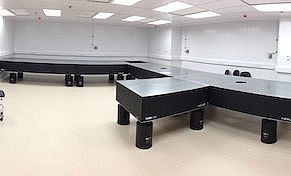 January 1, 2014Attosecond laboratory in Riyadh is taking shape
January 1, 2014Attosecond laboratory in Riyadh is taking shapeshort report — The Department of Physics and Astronomy’s Laboratory for Attosecond Physics at King Saud University is currently taking shape. The first tables for laser experiments were recently aligned in the cleanroom, the femtosecond laser-system has reached the University, and the beamline for the production of attosecond light-flashes and their application in basic research is also ready to be set up. From now on, the construction of scientific tools is taking place and by the end of 2014, the laboratory-infrastructure will be completed.